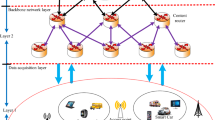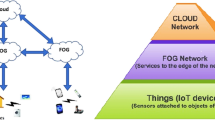Abstract
The concept of the Internet of Things (IoT)-based Wireless Sensor Network (WSN) is rapidly gaining wide-spread recognition and acceptance in our day-to-day lives. Nowadays, the application of the IoT sensor nodes in various domains of endeavors such as health-care, smart homes, industrial and production sectors, control networks, and in many other fields has continued to increase steadily. In IoT-based WSN, sensor nodes dynamically join the internet and collaborate to accomplish a mission by sensing and collecting event data from the application field. The sensor nodes thus forward the collected information to the sink nodes or to the nearest base station for further transmission. However, one of the significant drawbacks of the IoT-based WSN networks is that the battery life of the sensor nodes is often short-lived due to the energy-limited nature of the electronic sensors, resulting in the network’s short lifetime. Thus, prolonging the lifetime duration of the sensor nodes becomes a fundamental task. Whether the battery life of a sensor node is extended for a reasonable length of time or depleted in a moment depends mainly on the energy efficiency of the underlying routing protocol. Therefore, the issue of network lifetime can be fundamentally addressed by implementing an efficient and robust energy-aware routing protocol for sustainable and prolonged network operation time in a WSN based IoT network scenario. In this paper, a cluster-based Backpressure routing (CBPR) scheme has been proposed, which targets to prolong the network lifetime and enhance the data transmission reliability using energy load-balancing mechanism. For every cluster of the sensor node, the CBPR scheme elects a cluster head which has the highest energy level and the shortest distance to the sink node. The proposed CBPR routing scheme further utilizes a very robust data aggregation algorithm to checkmate and prevent the circulation of redundant data packets in the network while also exploiting the Backpressure scheduling machine for data packets queueing and for route selection, which allows it to select the next-hop sensor node based on the queue length value of the sensor nodes. Extensive simulations have been performed to evaluate the efficiency of the proposed CBPR routing scheme, which was compared with that of other well-known routing schemes such as the Information Fusion Based Role Assignment and Data Routing for In-Network Aggregation in terms of throughput, energy consumption, and packet delivery ratio.







Similar content being viewed by others
References
Ray, P. P., Mukherjee, M., & Shu, L. (2017). Internet of things for disaster management: State-of-the-art and prospects. IEEE Access, 5, 18818–18835. https://doi.org/10.1109/ACCESS.2017.2752174.
Mouradian, C., Naboulsi, D., Yangui, S., Glitho, R. H., Morrow, M. J., & Polakos, P. A. (2018). A comprehensive survey on fog computing: State-of-the-art and research challenges. IEEE Communications Surveys & Tutorials, 20(1), 416–464. https://doi.org/10.1109/COMST.2017.2771153.
Shi, W., Cao, J., Zhang, Q., Li, Y., & Xu, L. (2016). Edge computing: Vision and challenges. IEEE Internet of Things Journal, 3(5), 637–646.
Lin, J., Yu, W., Zhang, N., Yang, X., Zhang, H., & Zhao, W. (2017). A survey on internet of things: Architecture, enabling technologies, security and privacy, and applications. IEEE Internet of Things Journal, 4(5), 1125–1142.
Lu, R., Heung, K., Lashkari, A. H., & Ghorbani, A. A. (2017). A lightweight privacy-preserving data aggregation scheme for fog computing-enhanced IoT. IEEE Access, 5, 3302–3312.
Malathy, S. et al. (2020). “An optimal network coding based backpressure routing approach for massive IoT network”. Wireless Networks, pp. 1–18.
Amiri, I. S., et al. (2020). DABPR: A large-scale internet of things-based data aggregation back pressure routing for disaster management. Wireless Networks, 26(4), 2353–2374.
Heinzelman, W. B., Chandrakasan, A. P., & Balakrishnan, H. (2002). An application-specific protocol architecture for wireless microsensor networks. IEEE Transactions on Wireless Communications, 1(4), 660–670. https://doi.org/10.1109/TWC.2002.804190.
Boulfekhar, S., & Benmohammed, M. (2013). A novel energy efficient and lifetime maximization routing protocol in wireless sensor networks. Wireless personal communications, 72(2), 1333–1349.
Heinzelman, W. R., Chandrakasan, A., & Balakrishnan, H. (2000). "Energy-efficient communication protocol for wireless microsensor networks," IEEE, pp. 10-pp.
Dener, M. (2018). A new energy efficient hierarchical routing protocol for wireless sensor networks. Wireless Personal Communications, 101(1), 269–286.
Lindsey, S., & Raghavendra, C. S. (2002). PEGASIS: Power-efficient gathering in sensor information systems. IEEE, 3, 3–3.
Maheswar, R. & Jayaparvathy, R. (2010). "Performance analysis using contention based queueing model for wireless sensor networks," The International Congress for global Science and Technology, pp. 59–59.
Jayarajan, P., Maheswar, R., Sivasankaran, V., Vigneswaran, D., & Udaiyakumar,R. (2018). "Performance analysis of contention based priority queuing model using N-policy model for cluster based sensor networks," IEEE, pp. 0229–0233.
Maheswar, R., & Jayaparvathy, R. (2011). Performance analysis of cluster based sensor networks using N-policy M/G/1 queueing model. Eur. J. Scientific Research, 58(2), 177–188.
Jayarajan, P., Maheswar, R., & Kanagachidambaresan, G. R. (2019). Modified energy minimization scheme using queue threshold based on priority queueing model. Cluster Computing, 22(5), 12111–12118.
Maheswar, R., & Jayaparvathy, R. (2012). Performance analysis of fault tolerant node in wireless sensor network (pp. 121–126). New York: Springer.
Jayarajan, P., Maheswar, R., Kanagachidambaresan, G. R., Sivasankaran, V., Balaji, M., & Das, J. (2018). "Performance evaluation of fault nodes using queue threshold based on N-policy priority queueing model," IEEE, pp. 1–5.
Laktharia, K. I., Kanagachidambaresan, G. R., Maheswar, R., Mahima, V., & Darwish, A. (2017). "Buffer capacity based node life time estimation in wireless sensor network," IEEE, pp. 1–5.
Nageswari, D., Maheswar, R., & Kanagachidambaresan, G. R. (2019). Performance analysis of cluster based homogeneous sensor network using energy efficient N-policy (EENP) model. Cluster Computing, 22(5), 12243–12250.
Maheswar, R., Jayarajan, P., Vimalraj, S., Sivagnanam, G., Sivasankaran, V., & Amiri, I. S. (2018). "Energy efficient real time environmental monitoring system using buffer management protocol," IEEE, pp. 1–5.
Jayarajan, P., Kanagachidambaresan, G. R., Sundararajan, T. V. P., Sakthipandi, K., Maheswar, R., & Karthikeyan, A. (2020). An energy-aware buffer management (EABM) routing protocol for WSN. The Journal of Supercomputing, 76(6), 4543–4555.
Nakamura, E. F., de Oliveira, H. A. B. F., Pontello, L. F., & Loureiro, A. A. F. (2006). "On demand role assignment for event-detection in sensor networks," In 11th IEEE symposium on computers and communications (ISCC'06), 26–29, pp. 941–947, https://doi.org/10.1109/ISCC.2006.110.
Villas, L. A., Boukerche, A., Ramos, H. S., de Oliveira, H. A. B. F., de Araujo, R. B., & Loureiro, A. A. F. (2013). DRINA: A lightweight and reliable routing approach for in-network aggregation in wireless sensor networks. IEEE Transactions on Computers, 62(4), 676–689.
Tilwari, V., Dimyati, K., Hindia, M. H. D., Fattouh, A., & Amiri, I. S. (2019). Mobility, residual energy, and link quality aware multipath routing in MANETs with Q-learning algorithm. Applied Sciences, 9(8), 1582.
Tilwari, V., et al. (2020). MCLMR: A multicriteria based multipath routing in the mobile ad hoc networks. Wireless Personal Communications, 112(4), 2461–2483.
Tilwari, V., Dimyati, K., Hindia, M. H. D., Noor Izam, T. F. B. T. M., & Amiri, I. S. (2020). EMBLR: A high-performance optimal routing approach for D2D communications in large-scale IoT 5G network. Symmetry, 12(3), 438.
Tilwari, V., Hindia, M. N., Dimyati, K., Qamar, F., Talip, A., & Sofian, M. (2019). Contention window and residual battery aware multipath routing schemes in mobile ad-hoc networks. International Journal of Technology, 10(7), 1376–1384.
Rappaport, T. S. (1996). Wireless communications: Principles and practice. New Jersey: Prentice Hall PTR.
Hu, S., & Han, J. (2014). Power control strategy for clustering wireless sensor networks based on multi-packet reception. IET Wireless Sensor Systems, 4(3), 122–129.
Zheng, H., Yang, F., Tian, X., Gan, X., Wang, X., & Xiao, S. (2015). Data gathering with compressive sensing in wireless sensor networks: A random walk based approach. IEEE Transactions on Parallel and Distributed Systems, 26(1), 35–44.
Luo, D., Zhu, X., Wu, X., & Chen, G. (2011). "Maximizing lifetime for the shortest path aggregation tree in wireless sensor networks," IEEE, pp. 1566–1574.
Hai, L., Wang, J., Wang, P., Wang, H., & Yang, T. (2017). High-throughput network coding aware routing in time-varying multihop networks. IEEE Transactions on Vehicular Technology, 66(7), 6299–6309.
Acknowledgements
The authors would like to acknowledge the EPSRC grant EP/P028764/1 (UM IF035-2017) and Fundamental Research Grant Scheme (FRGS) (FP024-2020) for supporting this work.
Author information
Authors and Affiliations
Corresponding author
Additional information
Publisher's Note
Springer Nature remains neutral with regard to jurisdictional claims in published maps and institutional affiliations.
Rights and permissions
About this article
Cite this article
Maheswar, R., Jayarajan, P., Sampathkumar, A. et al. CBPR: A Cluster-Based Backpressure Routing for the Internet of Things. Wireless Pers Commun 118, 3167–3185 (2021). https://doi.org/10.1007/s11277-021-08173-0
Accepted:
Published:
Issue Date:
DOI: https://doi.org/10.1007/s11277-021-08173-0




